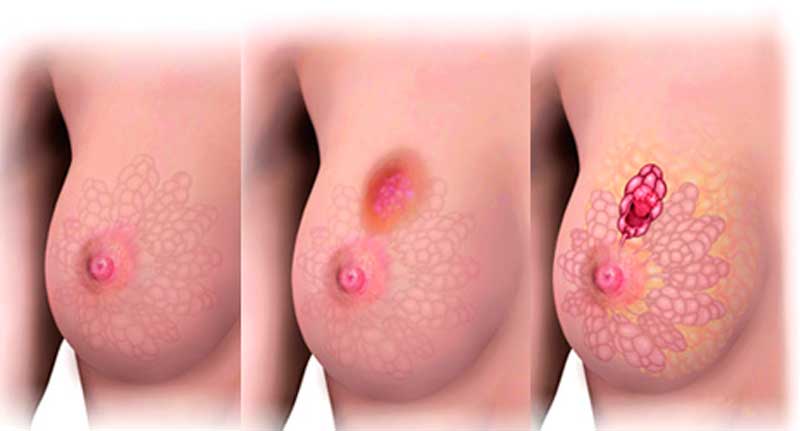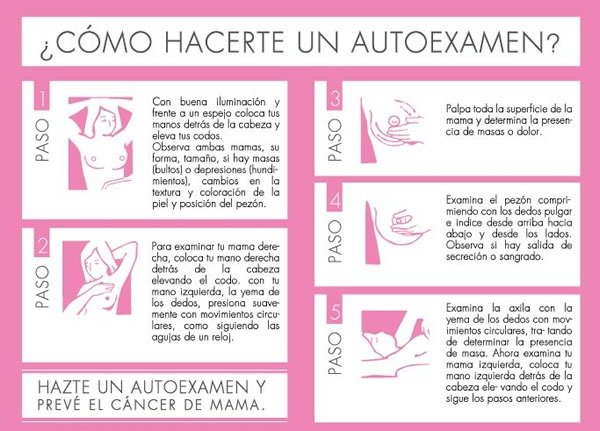Breast cancer
Breast cancer

Cancer originates when healthy breast cells begin to change and proliferate uncontrollably, forming a mass or cluster of cells called a tumor. A tumor can be cancerous or benign. A cancerous tumor is malignant, meaning it can grow and spread to other parts of the body. A benign tumor means the tumor can grow, but it will not spread.
Breast cancer spreads when it grows in other parts of the body or when cancerous cells travel to other parts of the body through blood vessels and / or lymphatic vessels. This is called metastasis.
Breast cancer can be invasive or non-invasive. Invasive breast cancer is a cancer that spreads to adjacent tissues. Noninvasive breast cancer does not extend beyond the milk ducts nor the lobules of the breast. Most types of breast cancer begin in the ducts or lobes, and are called ductal carcinomas or lobular carcinomas.
Ductal carcinoma. These cancers originate in the cells that internally coat the milk ducts and make up the majority of breast cancers.
Ductal carcinoma in situ (DCIS). This cancer is located only in the duct.
Invasive or infiltrating ductal carcinoma. This cancer spreads out of the duct.
Lobular carcinoma. This cancer originates in the lobes.
Lobular carcinoma in situ (LCIS). The LCIS is located only in the lobes. LCIS is not considered a cancer. However, LCIS is a risk factor for the development of invasive breast cancer in both breasts.
The main risk factors for getting breast cancer include advanced age, first menstruation at an early age, advanced age at the time of first birth or never having given birth, family history of breast cancer, consuming such hormones Such as estrogen and progesterone, consuming liquor and being white.2 Between 5 and 10% of cases, breast cancer is caused by inherited genetic mutations.
Signs and symptoms that should be discussed with your doctor include:
A lump that feels like a firm knot or a thickening of the breast or under the arm. It is important to feel the same area of the other breast to make sure that the change is not part of the healthy breast tissue of that area.
- Any change in the size or shape of the breast.
- Nipple discharge that occurs suddenly, contains blood or occurs only in a breast.
- Physical changes, such as an inverted nipple or a sore in the nipple area.
- Irritation of the skin or changes in the skin, such as roughness, dimples, scaliness or new folds.
- Warm, red and swollen breasts, with or without rash that resembles the skin of an orange, called "orange peel".
- Pain in the breast; Particularly, pain in the breast that does not go away. Pain is usually not a symptom of breast cancer, but it should be reported to the doctor.
The following factors may increase the risk of a woman developing breast cancer:
Age. The risk of developing breast cancer increases as a woman ages and, in most cases, the disease develops in women over 50 years of age.
Personal history of breast cancer. A woman who has had cancer in one breast has a higher risk of developing a new cancer in either breast.
Family history of breast cancer. Breast cancer can be hereditary if your family has one or more of the following characteristics:
Relatives of the first degree, such as mothers, sisters and children, who have been diagnosed with breast or ovarian cancer, especially before the age of 50. If 2 first-degree relatives developed breast cancer, the risk is 5 times the average risk.
Many close relatives who have been diagnosed with breast or ovarian cancer, especially before age 50. Close relatives include grandparents, uncles and aunts, nephews and nieces, grandchildren and cousins.
A member of the family who has developed breast cancer in both breasts.
A related male who has developed breast cancer. It is uncertain how much a woman's risk of having breast cancer increases when a man in the family has breast cancer, unless it is due to a hereditary mutation.
If a man in your family has developed breast cancer or a woman has developed breast cancer early or has developed ovarian cancer, it is important to talk to your doctor. This could be a sign that your family carries a hereditary mutation of the breast cancer gene, such as BRCA1 or BRCA2.
Inherited risk / genetic predisposition. There are several hereditary genes linked to an increased risk of developing breast cancer as well as other types of cancer. BRCA1 or BRCA2 genes are the most commonly known mutations. Mutations of these genes are linked to an increased risk of developing breast and ovarian cancer, as well as other cancers. The risk of a man developing breast cancer, as well as the risk of having prostate cancer, also increases if he has mutations of these genes.
How can you detect breast cancer?
Mammography is the best tool for doctors to detect breast cancer in healthy women, as it has been shown to reduce mortality from the disease. Like any medical examination, mammography involves risks, such as additional tests and anxiety in the event that the test erroneously shows a possible tumor; This is called a false positive. In 10% to 15% of cases, the mammogram will not show an existing cancer, which is called false negative.
Other ways to examine breasts, such as ultrasound or magnetic resonance imaging (MRI), are not regularly used to detect breast cancer in many women. However, these tests may be helpful for women who are at very high risk of developing breast cancer, those with dense breast tissue or when a lump or mass is detected during a breast exam. The use of ultrasound for detection is controversial since it has a high rate of false positives. This means that the test mistakenly identifies possible cancers.
A biopsy is the removal of a small amount of tissue for examination through a microscope.
Biopsy by aspiration with fine needle. Use a small needle to remove a small sample of cells.
Deep needle biopsy. Use a wider needle to remove a larger sample of tissue. It is usually the preferred biopsy technique to determine if an anomaly detected on a physical examination or an imaging test is cancer. Local anesthesia, which is a pain-blocking medication, is used to reduce the patient's discomfort during the procedure.
Surgical biopsy. It removes the largest amount of tissue. Because it is best to do the surgery after the cancer diagnosis has been made, a surgical biopsy is not usually recommended as a method of diagnosis of breast cancer. More often than not, deep nonsurgical needle biopsies are recommended to diagnose breast cancer. This means that only one surgical procedure is needed to remove the tumor and to take samples from the lymph nodes.
Biopsy guided by images. During this procedure, a needle is guided to the necessary location with the aid of an imaging technique, such as a mammogram, ultrasound or MRI. A stereotactic biopsy is done with mammography as a guide to guide the needle.
Sentinel lymph node biopsy. It is a way to find out if the lymph nodes near the breast have cancer.
Personal opinion.
Currently we are in a time where the cancer is very named, it is important to know our body, to touch us is an effective tool to detect in time some anomaly of our breasts.

source.
http://www.cancer.net/es/tipos-de-c%C3%A1ncer/c%C3%A1ncer-de-mama/introducci%C3%B3n
source.
Where do tumors come from?
When considering treatment options for cancer, it's important to work with a reputable healthcare provider who has experience in treating the specific type of cancer you have. This may involve seeking a second opinion or consulting with a specialist who is familiar with the latest research and treatment options with how much Dca do i take. It's also important to be an active participant in your own care and to ask questions, share concerns, and advocate for yourself throughout the treatment process.
Hola @roxana85, upv0t3
Este es un servicio gratuito para nuevos usuarios de steemit, para apoyarlos y motivarlos a seguir generando contenido de valor para la comunidad.
<3 Este es un corazón, o un helado, tu eliges .
: )
N0. R4ND0M:
4277 3403 8877 9933
6035 7297 9295 6125
3374 6028 9255 2879
2512 5207 7550 7672
Congratulations @roxana85! You have received a personal award!
Click on the badge to view your Board of Honor.
Do not miss the last post from @steemitboard:
SteemitBoard World Cup Contest - Final results coming soon
Congratulations @roxana85! You received a personal award!
You can view your badges on your Steem Board and compare to others on the Steem Ranking
Vote for @Steemitboard as a witness to get one more award and increased upvotes!